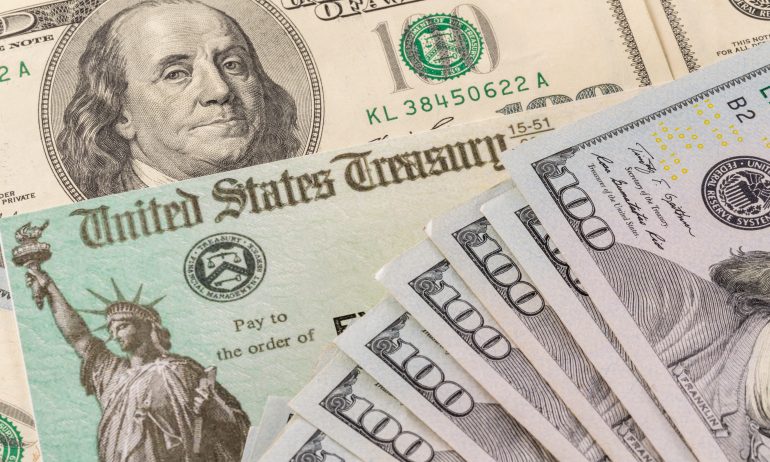What Is the National Debt?
The national debt is a major bellwether of a country's economic health.

Many, or all, of the products featured on this page are from our advertising partners who compensate us when you take certain actions on our website or click to take an action on their website. However, this does not influence our evaluations. Our opinions are our own. Here is a list of our partners and here's how we make money.
Updated on March 26.
The national debt is the sum total of all the money the United States government has borrowed but not yet repaid. The current national debt is $36.2 trillion, according to the U.S. Treasury Department. The figure represents how much the U.S. owes its creditors, which include the American public, foreign governments, securities holders and even its own government agencies.
The national debt is projected to increase by $23.9 trillion over the next 10 years, according to a report released on Jan. 17 by the Congressional Budget Office (CBO). The increase in the cumulative deficit would primarily be due to increased spending and interest expenses surpassing tax revenue.
The CBO also projects that the federal budget deficit in fiscal year 2025 is on pace to grow by $1.9 trillion.
What is the U.S. national debt right now?
The U.S. national debt currently stands at more than $36.2 trillion, according to the U.S. Treasury Department. The country’s national debt per capita — or, how much money it owes per citizen — is around $106,000.
The total debt might sound like a staggering sum — and in many ways, it is. To understand just how staggering, consider that amount in its broader context. Economists like to compare a nation’s debt against its gross domestic product, which measures the value of all goods and services produced in that country, to get a fuller picture of a nation’s ability to repay those debts.
For example, the U.S. ended the 2024 fiscal year with a debt-to-GDP ratio of 123%, according to data from the U.S. Treasury. Basically, that means the national debt accounts for roughly 123% of its annual GDP.
How does the national debt work?
Like an everyday citizen, the federal government both earns and spends money. It makes much of its money by collecting taxes. It spends that revenue on programs and services for citizens, as well as interest on debts. When the government spends more than it earns, it has a budget deficit.
» MORE:
So the government has to borrow money to pay off that deficit. The national debt is the aggregate amount of money, plus interest, that the government owes its borrowers.
The national debt is made up of several kinds of debt, just like an individual’s debts might include credit card debt, a car payment, student loans and a mortgage. Some of the different kinds of debt that make up the national debt include:
Marketable securities. Marketable securities are assets that can be bought and sold on different markets. They can come in many different forms — bonds, bills or company shares, for example — that can be quickly converted into cash.
The Treasury offers five kinds of marketable securities: bills, notes, Treasury inflation-protected securities, floating rate notes and bonds.
Non-marketable securities. Non-marketable securities, on the other hand, are different types of financial securities that cannot be easily sold or converted to cash. Examples of non-marketable securities include U.S. savings bonds or a share of a private company.
Intragovernmental debt. Intragovernmental debt is money that one government agency owes another.
Debt held by the public. Publicly held debt includes federal debts held by companies, local or state governments or individuals — basically, any entity that isn’t the U.S. federal government.
Who owns the U.S. national debt?
Most of the national debt is owned by the public and it includes the amount the Treasury borrowed from outside lenders via financial markets. Public debt holders include the Federal Reserve System, mutual funds, depository institutions, state and local governments, pension funds, insurance companies, foreign countries and other domestic holders.
Roughly 20% of the national debt is categorized as intragovernmental, which refers to debt owed to the government by different branches or departments. This category isn't a traditional debt in the way a public debt is. Rather, it shuffles money around from one department to another in order to fund programs. But accounting of the funds must be tracked. The largest portion of intragovernmental debt is the Social Security Old-Age and Survivors Insurance Trust Fund.
As of March 24, the total outstanding national debt is $36.2 trillion. Here’s how that breaks down:
Intragovernmental holdings: $7.3 trillion.
Debt owned by the public: $28.9 trillion.
Reliance on foreign lenders has increased over recent decades. As of January 2025, these foreign countries hold the largest volumes of U.S. Treasury securities, according to the U.S. Treasury’s most recently available data.
Japan: $1.079 trillion
China: $760.8 billion
United Kingdom: $740.2 billion
Luxembourg: $409.9 billion
Cayman Islands: $404.5 billion
Belgium: $377.7 billion
Canada: $350.8 billion
How does the government pay off its debt?
The government doesn’t completely pay off its debt — it just manages it over time. The main drivers of revenue are collecting tax revenue and issuing Treasury securities.
Other factors that could impact debt management include expanding economic conditions, such as job and wage growth — which leads to more taxable income — as well as inflation, which decreases the value of the debt. Government policies like reduced spending, increasing the tax rate and selling government assets (like foreign lands) can increase revenue, as well.
Budget surpluses can also reduce debt; the U.S. hasn’t had a surplus since the Clinton Administration.
Debt may also decrease when people cash in enough Treasury securities to exceed the total amount of securities that people buy.
Why does the national debt matter?
The national debt is a bellwether of a nation’s economic health. When a country starts carrying a lot of debt, individuals and companies may lose confidence in the economy, which can affect how they spend or invest their money. For example, if certain investors lose confidence in the U.S.’s ability to pay down its debts, they might sell off Treasury bonds, which would weaken the dollar.
Declining confidence in the U.S. government could also raise interest rates, which would then hamstring individuals and companies who need to borrow money, too. That’s a recipe for waning investments and slower economic growth — both of which would adversely impact workers’ wages.
When has the national debt risen in the past?
Spikes in the national debt go back hundreds of years. The Treasury notes that the debt greatly increased during the Revolutionary and Civil Wars, as well as in World War I and World War II.
More recently, the government borrowed significant sums during the Afghanistan and Iraq Wars and the 2008 recession. The U.S. national debt has since risen every year in the past decade.
The Treasury reports that national spending rose 50% between fiscal years 2019 and 2021, mostly due to the pandemic. Major spending, paired with significant tax cuts, is part of how the government arrived at its current national debt.
What’s the difference between the debt ceiling and the national debt?
The debt ceiling and the national debt aren’t the same, but they relate to one another. The debt ceiling is the total the government is allowed to borrow to pay its legal obligations before it defaults.
The national debt is the total amount of outstanding money that is currently borrowed by the federal government, plus interest.
Occasionally, Congress has to hold a vote over whether to raise the debt ceiling. Refusing to vote to lift the debt ceiling would not bring down the national debt — it would mean the government cannot repay the debt it already has.


